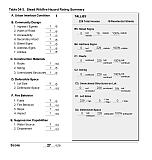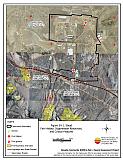34.0 Stead
34.1 Risk and Hazard Assessment
The community of Stead is located east of Silver Knolls, west of Lemmon Valley, north of the Reno-Northwest community, and south of the Stead Airport. The community is situated in Lemmon Valley east of Silver Lake as shown in Figure 34-1. The community hazard assessment resulted in classifying Stead in the Low Hazard Category (27 points). A summary of factors that contributed to the hazard rating is included in Table 34-3. Primary factors that determined the hazard rating in Stead included the high number of homes with adequate defensible space and the high availability of career-level fire suppression resources throughout the community.
34.1.1 Community Design
The wildland-urban interface area in Stead is characterized as a classic interface condition. There is a clear line of demarcation between wildland fuels and the residential structures in the community. All of the residences are located on lots less than one acre in size.
- Access: US Highway 395, Stead Boulevard, and Sky Vista Parkway are the primary transportation routes providing access to and from the community. The roads are greater than 24 feet wide and provide adequate space for two-way vehicular travel and for fire suppression equipment to maneuver.
- Signage: All of the streets signs in the community are easily visible. Also, all of the residential addresses are easily visible from the road. Clear and visible street signs and residential addresses are important in locating homes during low visibility conditions that occur during a wildfire.
- Utilities: All utilities are above ground. Power lines have been properly maintained in all areas of the community. Proper maintenance minimizes the possibility that arcing may start fires in nearby vegetation.
34.1.2 Construction Materials
All of the homes in the interface are built with non-combustible or ignition resistant siding such as medium density fiberboard, stucco, or brick. Also, all of the homes have roofs of non-combustible material such as tile, metal, or composition. No homes were observed to have unenclosed balconies, porches, decks, or other architectural features that create drafty areas where sparks and embers can be trapped, smolder, ignite, and rapidly spread fire to the house.
34.1.3 Defensible Space
All of the homes surveyed in Stead have landscaping that meets defensible space guidelines to protect the home from damage or loss during a wildfire.
34.1.4 Suppression Capabilities
Wildfire Protection Resources
The community of Stead is included in the Reno Fire Protection District. The standard Reno Fire Department dispatch for a wildland fire is shown in Table 34-1. Other local, state, and federal resources are available upon request through mutual agreements as described in Section 4.1.1.
| Type of Resource | Amount of Equipment | Cooperating Partner (Resource Location) |
|---|---|---|
| Engine Type 3 Engine Type 1 Water Tender Battalion Chief Safety Officer |
3 1 1 1 1 |
Reno Fire Department (Closest available career and volunteer resources) |
| Source: Roy Slate, and Marty Scheuerman, Reno Fire Department | ||
Detection and Communication
Fires are reported in Washoe County through the 911 system, which connects the call with the Washoe County 911 Center. Washoe County 911 notifies the Sierra Front Interagency Dispatch Center of wildland fires. The Sierra Front Interagency Dispatch Center notifies the Volunteer Fire Departments, the Nevada Division of Forestry, the Bureau of Land Management, and the US Forest Service of fires through the use of pagers and radios.
Communication frequencies are currently compatible between agencies. When the federal agencies go to narrow band digital radios, the Reno Fire Department may no longer be able to communicate with the Bureau of Land Management and US Forest Service.
Water Sources and Infrastructure
Stead has fire hydrants with minimum flow ratings of 1,000 gallons per minute within 1,000 feet of structures. The hydrant system is gravity fed and supplied by several water storage tanks. They do not have an emergency backup generator to refill storage tanks in the event of a power failure. The estimated round trip time from parts of the community that do not have hydrants to additional water supplies to refill fire apparatus is approximately twenty minutes or less.
Fire Protection Personnel Qualifications
The Reno Fire Department firefighters are required to have at least forty hours of basic wildland training and they are required to attend eight hours of annual wildland refresher training. The Reno Fire Department meets the NWCG 310-1 wildland requirements for training. The Department is in the process of providing additional training for Captains and Chief Officers. They do not currently use the red card system. Many Reno Fire Department members are trained to a higher level and are certified through the red card system, but this is at the discretion of the individual.
Financial Support
The Reno Fire Department is funded from the City of Reno General Fund.
Community Preparedness
Stead is included in the Washoe County All-Risk Emergency Plan.
34.1.5 Factors Affecting Fire Behavior
The terrain in the wildland-urban interface areas of Stead is generally flat with less than eight percent slopes. The prevailing wind direction is from the south and southwest. High wind speeds are common during summer afternoons. The vegetative fuels in the Stead area consist of big sagebrush and rabbitbrush with Indian ricegrass, bottlebrush squirreltail, skeleton weed, cheatgrass, and Russian thistle between and underneath shrub canopies. The fuel load in these areas was estimated at two tons per acre and was considered a moderate fuel hazard. There are still large open space natural areas with moderate brush within the community and adjacent to many developed properties.
34.1.6 Fire Behavior Worst-Case Scenario
The worst-case scenario for Stead would be a fire starting on a high hazard day in an undeveloped area of moderately dense brush within the community. With strong winds, greater than twenty miles per hour, this fire could quickly threaten wood and/or vinyl fencing and throw firebrands into structures. These large open space areas around structures could quickly be consumed by wildfire burning several hundred acres at a time.
34.1.7 Ignition Risk Assessment
Stead has a moderate ignition risk. The area has a tendency for afternoon thunderstorm activity in the summer and increasing population density and heavy traffic increase the chances for a human caused ignition.
34.2 Risk and Hazard Reduction Recommendation
The responsibility to keep a community fire safe falls not only on the local fire protection district but also on the residents of the community, businesses, and local governments. The hazard reduction recommendations for Stead focus on defensible space and fuels reduction within the community.
34.2.1 Defensible Space Treatments
Defensible space treatments are an essential first line of defense for residential structures. The goal of the treatments is to significantly reduce or remove flammable vegetation within a prescribed distance from structures. (Refer to Appendix E for the recommended defensible space area). Defensible space reduces the fire intensity and improves firefighter and homeowner chances for successfully defending a structure against oncoming wildfire.
Property Owner Recommendations
- Remove, reduce, and replace vegetation to create defensible space around homes according to the guidelines in Appendix E. This area should be kept:
- Lean: There are only small amount of flammable vegetation.
- Clean: There is no accumulation of dead vegetation or other flammable debris.
- Green: Existing plants are healthy and green during the fire season.
- Store firewood a minimum distance of thirty feet from structures.
- Mow or remove brush growing against fences in the community. The minimum distance for clearance should be ten feet in grass and 25 feet in brush.
- Enclose areas under wood decks and porches when possible or maintain these areas to be free of weeds and other flammable debris. Box in eves and cover ventilation openings with very fine metal wire mesh to prevent embers from entering the attic and crawl spaces.
- Clear all vegetation and combustible materials around propane tanks for a minimum of ten feet.
- Clear weeds and brush to a width of ten feet along both sides of the driveways.
- Maintain a minimum clearance of thirty feet from the crown of trees that remain within the defensible space zone. Keep this area free of smaller trees, shrubs, and other ladder fuels.
- Trim and remove tree branches a minimum of four feet from the ground to reduce ladder fuels on all deciduous and coniferous trees within the defensible space zone. Prune all dead and diseased branches.
- Prune all tree branches to a minimum distance of fifteen feet from buildings, paying special attention around chimneys.
- Install spark arrestors on chimneys.
- Mow grass within the defensible space zone to maintain a maximum height of four inches.
- Thin sagebrush and other shrubs to a spacing between shrubs that is equal to twice the shrub height.
- Immediately dispose of cleared vegetation when implementing defensible space treatments. This material dries quickly and poses a fire hazard if left on site.
- Where possible, irrigate all trees and large shrubs that remain in close proximity to structures to increase their fire resiliency. This is especially important during drought conditions.
- Maintain the defensible space as needed.
Reno Fire Department Recommendation
- Conduct courtesy inspections of home defensible space measures.
34.2.2 Fuels Reduction Treatments
Fuel reduction treatments are applied on a larger scale than defensible space treatments. Permanently changing the fuel characteristics over large blocks of land to one of a lower volume and altered distribution reduces the risk of a catastrophic wildfire in the treated area. Reducing vegetation along roadways and driveways could reduce the likelihood of blocking access and escape routes, help contain the fire perimeter, and improve firefighter access and safety for protecting homes.
Reno Fire Department Recommendation
- Develop and promote a program for cleaning weeds and debris from around structures and fences in the community and for biomass disposal. Continue to enforce the permit process for open burning.
34.2.3 Community Coordination
Washoe County Recommendations
- Continue to require all future development in the County to meet the National Fire Codes with regard to community design, building construction and spacing, road construction and design, water supply, and emergency access. Refer to Appendix F for an example of fire safe recommendations for planning new developments.
- Facilitate coordinated and collaborative efforts at the County and State levels for consistency in fire safe community planning and enforcement of fire safe ordinances in a unified manner.
34.2.4 Public Education
A public education program that explains fire safe measures in clear and emphatic terms will have an impact on residents of the wildland-urban interface. Informed community members will be more inclined to make efforts to effectively reduce wildfire hazards around their homes and neighborhoods.
Reno Fire Department Recommendation
- Distribute copies of the publication “Living with Fire” to all property owners. This publication is free of charge. Copies can be requested from the University of Nevada Cooperative Extension.
34.3 Summary of Recommendations
| Involved Party | Recommended Treatment | Recommendation Description |
|---|---|---|
| Property Owners | Defensible Space Treatments | Remove, reduce, and replace vegetation around homes according to the defensible space guidelines in Appendix E. |
| Washoe County | Community Coordination | Continue to require all future development in the County to meet the National Fire Codes with regard to community design, building construction and spacing, road construction, water supply, and emergency access. Facilitate coordinated and collaborative efforts at the County and State levels for consistency in fire safe community planning and enforcement of fire safe ordinances in a unified manner. |
| Reno Fire Department | Defensible Space Treatments | Conduct courtesy inspections of home defensible space measures. |
| Fuels Reduction | Develop and promote regular brush clearance and biomass disposal, and continue to enforce the open burn permit programs. | |
| Public Education | Distribute copies of the publication “Living with Fire” to all property owners. |
Table 34-3Stead Wildfire Hazard Rating Summary |
 |
Figure 34-1Stead Fire History, Suppression Resources, and Critical Features |
 |
